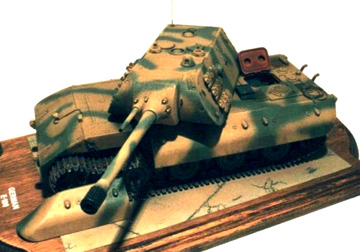
Model by David Coyne, Dublin Ireland
Panzerkampfwagen E100
Model by David Coyne, Dublin Ireland

The E-100 was originally designed as an Waffenamt alternative to
the Porsche-designed superheavy Maus tank. It was authorized in June, 1943 and work
in earnest continued until 1944 when Hitler officially ended development of superheavy
tanks. After Hitler's announcement, only three Alder employees were allowed to
continue assembly of the prototype, and the work was given lowest priority. Even
with these handicaps, the three workers were able to virtually complete the
prototype by war's end at a small Henschel facility near Paderborn. The prototype
lacked only a turret (which was to be identical to the Maus turret save in armament).
For it's initial tests, a Tiger II Maybach HL230P30 engine had been fitted. This engine,
of course, was far too weak to properly power the 140 ton E-100. The production engine was
to be the Maybach HL234. The HL234 developed 800hp, which is only 100hp better than the
HL230P30. Some sources indicate that a Diamler-Benz diesel which developed 1000hp would
have ultimately been used.
The Maus mounted the 12.8cm KwK 44 L/55 found in the Jagdtiger. Using the same turret, the E-100 was initially slated to use the 15cm KwK44 L38, but provision was made to eventually up-gun the vehicle with a 17cm KwK 44.
The E-100 was very conventional in its architecture. The standard rear-engine / front-drive
layout was maintained. The engine deck of the Tiger II was also carried over into this design
(rather than the updated designof the E 50/75). The suspension was characteristic of the
E-series, however, in that it was of the externally-mounted Belleville Washer type. While the
engine-deck layout of the prototype was taken directly from the Tiger II, it is entirely possible that
it would have been changed to match the E 50/75 had production of the E-series actually began
to allow for maximum commonality of components.
The armor on the E-100 was designed to withstand hits from just about any
anti-tank round of the day. Armor on the turret ranged from 200mm on the sides and rear to 240mm
on the front. The turret roof was protected by a seemingly paltry 40mm of armor. Unfortunately, the
round shape of the turret front could have deflected shots downward
into the top of the superstructure. Armor protection on the superstructure varried from 200mm on the
front to a total of 180mm on the sides and 150mm on the rear. The top of the superstructure was protected
by the same 40mm of armor found on the turret. The hull had 150mm of armor on the front and rear and
120mm on the sides behind the suspension. Protection on the bottom of the hull was good at 80mm.
Given the armored protection of the E-100, most tanks would have needed a shot to deflect
into the top of the superstructure from the turret front to knock it out. The vehicle would have, however,
been highly vunerable to air attack as the angles presented to dive bombers or fighter/bombers would
have been protected to only 40mm. This protection is comparable to the Tiger II in the same areas.
| Panzerkampfwagen E-100 | |
|---|---|
| Crew: 5 | Armament: one 15cm KwK44 L/38 + one 7.5cm KwK44 L/36.5 + one (or three) 7.92mm MG34 |
| Weight: 140 tons | Traverse: 360o (power) |
| Length: 10.27 meters | Elevation: -7o +23o |
| Width: 4.48 meters | Engine: Maybach HL234 |
| Height: 3.29 | Gearbox: 8 forward, 4 reverse (with provision for Mekydro transmission) |
| Radio: FuG5 | Speed: 40 km/hr |
(Credit coming soon)